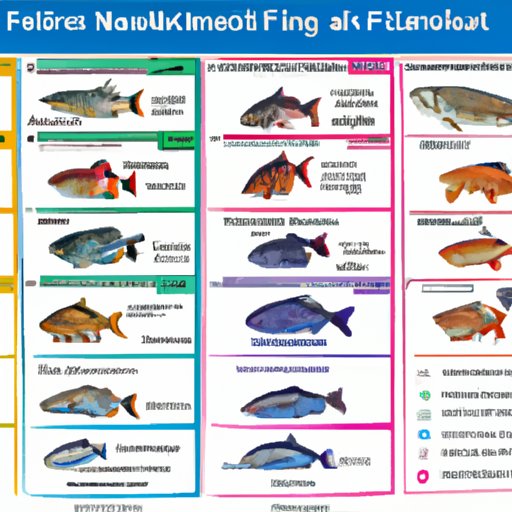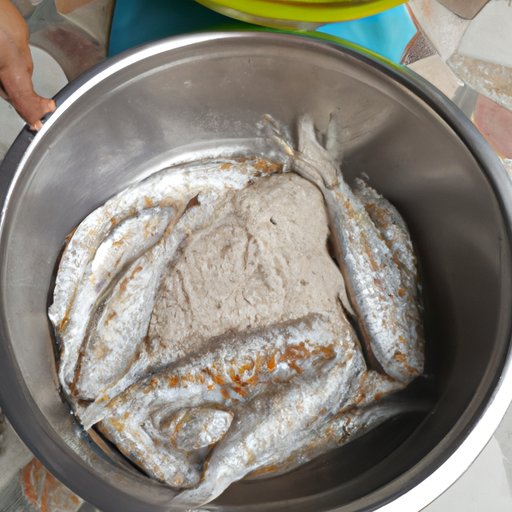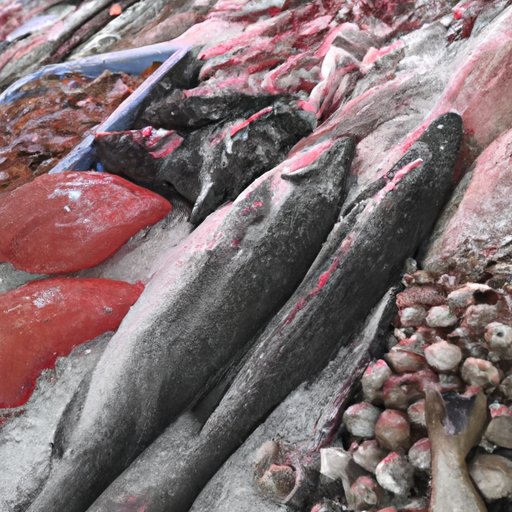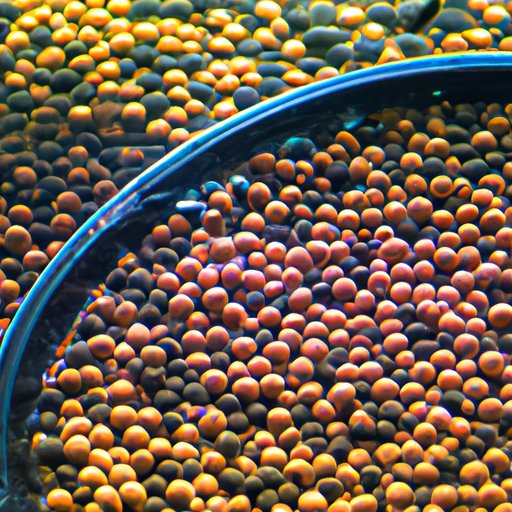Introduction
Having a healthy and well-maintained aquarium requires more than just regular water changes and tank maintenance. One of the most important aspects of aquarium care is providing the right diet for your fish. Fish have specific nutritional needs and require a variety of foods in order to stay healthy. Understanding what fish should eat, how often they should be fed, and the benefits of different types of fish food can help ensure that your aquatic pets remain happy and healthy.

Overview of Fish Eating Habits and Nutritional Needs
Fish are unique creatures with diverse dietary needs. While some species are omnivores, others are carnivores or herbivores. Each type of fish has its own nutritional requirements, which must be met for them to remain healthy. In general, fish need a balanced diet that includes proteins, carbohydrates, fats, vitamins, minerals, and other essential nutrients. The type and amount of food needed will vary depending on the species of fish, their age, and activity level. For example, young fish need more protein than adults, while active fish require more energy-dense foods.
Why Variety is Important for Fish Diets
Providing a variety of foods is essential for maintaining the health of your fish. According to research published by the American Society of Ichthyologists and Herpetologists, “feeding a variety of items from different sources ensures that all dietary requirements are met, and helps prevent nutritional deficiencies.” Variety also helps to keep fish from becoming bored with their diets, which can lead to health issues. By providing a variety of foods, you will ensure that your fish receive all the nutrients they need to stay healthy and happy.
Types of Fish Food
There are many types of fish food available for aquariums, and it can be difficult to know which ones are best for your fish. Here are some of the common types of fish food and the benefits they provide.
What to Feed Aquarium Fish
Live food is one of the most popular options for aquarium fish. Live foods include insects, worms, crustaceans, and other small animals. These foods provide a variety of vitamins and minerals, as well as protein and fat. Live foods also offer mental stimulation for fish, as they must hunt for their food.
Frozen foods are another option for aquarium fish. These foods are typically frozen versions of live foods, such as shrimp, worms, and other small animals. Frozen foods are convenient and can be stored for longer periods of time than live foods. They also provide a variety of vitamins and minerals, as well as protein and fat.
Dry foods are the most common type of fish food. These include flakes, pellets, and freeze-dried foods. Dry foods are convenient and easy to store, but they may lack some of the vitamins and minerals found in live and frozen foods. They are also not as mentally stimulating as live foods.
Best Diets for Different Types of Fish
The best diet for your fish will depend on their species and life stage. Freshwater fish typically require a high-protein diet, while saltwater fish need a higher fat content. Herbivorous fish need a diet that is high in plant matter, while carnivorous species require a diet that is rich in animal proteins. It is important to research the dietary needs of your particular species of fish and provide a diet that meets those needs.

How to Make Homemade Fish Food
Making your own fish food is a great way to ensure that your fish get a variety of nutrients. Preparing homemade fish food is relatively simple and can be done using ingredients that you likely already have in your kitchen. Here are the steps for making homemade fish food:
Steps for Preparing Homemade Fish Food
1. Gather the ingredients. You will need a protein source (such as shrimp, squid, or clams), vegetables (such as spinach, kale, or carrots), and a binding agent (such as eggs, gelatin, or oatmeal).
2. Blanch the vegetables. Place the vegetables in boiling water for 2-3 minutes, then remove and let cool.
3. Blend the ingredients. Place the protein source, vegetables, and binding agent into a blender and blend until smooth.
4. Freeze the mixture. Pour the mixture into ice cube trays and freeze overnight.
5. Serve the fish food. Place the cubes into a zip-top bag and store in the freezer. When ready to feed, thaw a cube and serve to your fish.
Benefits of Home-Prepared Fish Food
Homemade fish food provides a variety of benefits for your fish. It is more economical than store-bought food, and it allows you to customize the ingredients to meet the specific needs of your fish. Additionally, homemade fish food is free of preservatives and additives, which can be harmful to fish. Finally, preparing your own fish food gives you peace of mind knowing exactly what your fish are consuming.

An Overview of Commercial Fish Foods
Commercial fish foods are widely available and come in a variety of forms. Here is an overview of the most common types of commercial fish food:
Varieties of Commercial Fish Food
Flakes are one of the most popular types of commercial fish food. Flakes are easy to use and provide a variety of vitamins and minerals. Pellets are another popular option and are available in various sizes. They provide a balanced diet and are usually fortified with vitamins and minerals. Freeze-dried foods are also available, and these are typically a mix of proteins, vegetables, and other ingredients. Finally, there are specialty foods designed for specific types of fish, such as goldfish or koi.
Pros and Cons of Commercial Fish Foods
Commercial fish foods are convenient and widely available, making them a popular choice for aquarium owners. However, they can also be expensive and may contain fillers and preservatives that can be harmful to fish. Additionally, some commercial fish foods are not nutritionally complete, so it is important to read the labels carefully to ensure that the food you choose is appropriate for your fish.
Understanding Fish Feeding Habits and Schedules
In addition to understanding what types of food to feed your fish, it is also important to understand their feeding habits and create a schedule that meets their needs. Here are some factors to consider when creating a feeding schedule for your fish:
Factors Affecting Feeding Habits
Water temperature, oxygen levels, and light levels all affect the appetite of fish. If any of these factors are out of balance, it can cause stress in fish, which will decrease their appetite. Additionally, some species of fish are naturally more active than others, which can influence how much and how often they need to be fed.
Recommended Feeding Schedules
It is recommended to feed your fish two to three times per day. Smaller meals are generally better than larger meals, as this can help reduce waste and keep the water quality in the aquarium stable. Additionally, it is important to monitor your fish’s behavior and adjust the feeding schedule accordingly. If your fish are not eating, it may be necessary to reduce the amount or frequency of feedings.
Conclusion
Providing a balanced and nutritious diet for your fish is essential for their health and wellbeing. Understanding what types of food to feed, how to make homemade fish food, and the benefits of different types of fish food can help you ensure that your fish get the nutrients they need. Additionally, understanding fish feeding habits and creating a feeding schedule that meets their needs can help keep your fish healthy and happy.
Summary of the Benefits of Variety in Fish Diets
Providing a variety of foods is important for the health of your fish. Variety helps to ensure that all of your fish’s dietary needs are met, prevents boredom, and can help keep your fish healthy and happy. There are many types of fish food available, including live, frozen, and dry foods, as well as homemade and commercial options.
Final Thoughts on Fish Eating Habits and Nutritional Needs
Creating a healthy diet for your fish is an important part of aquarium care. Understanding what fish should eat, how often they should be fed, and the benefits of different types of fish food can help ensure that your aquatic pets remain happy and healthy. With the right diet and feeding schedule, you can enjoy a vibrant and thriving aquarium for years to come.
(Note: Is this article not meeting your expectations? Do you have knowledge or insights to share? Unlock new opportunities and expand your reach by joining our authors team. Click Registration to join us and share your expertise with our readers.)
